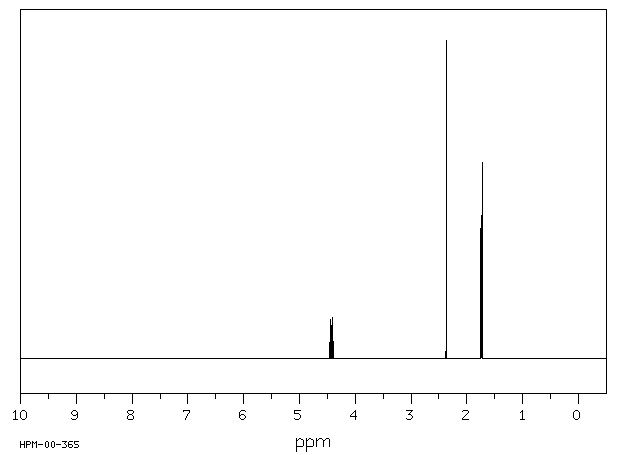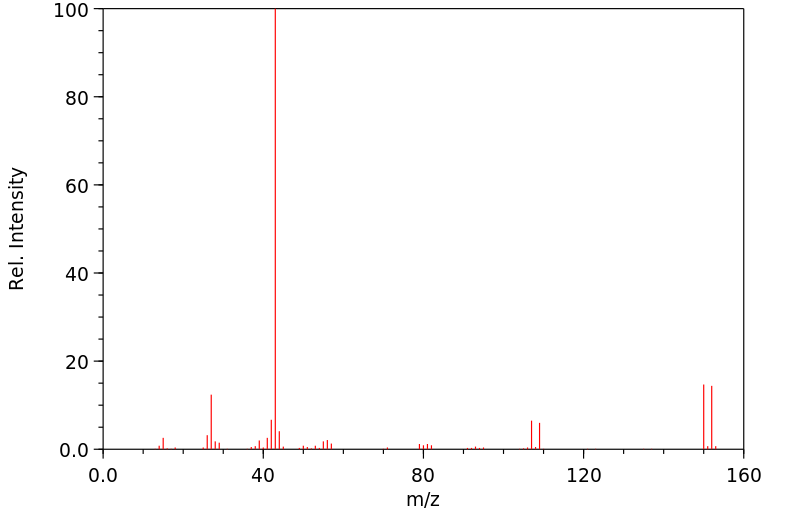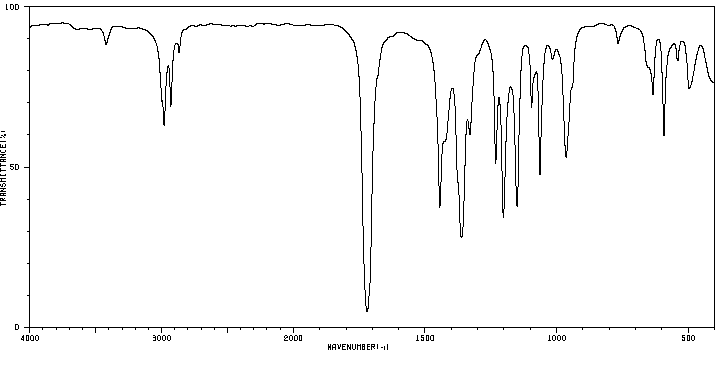3-溴-2-丁酮 | 814-75-5
中文名称
3-溴-2-丁酮
中文别名
3-溴丁酮
英文名称
3-bromo-butanone
英文别名
3-Bromo-2-butanone;3-bromobutan-2-one
CAS
814-75-5
化学式
C4H7BrO
mdl
——
分子量
151.003
InChiKey
BNBOUFHCTIFWHN-UHFFFAOYSA-N
BEILSTEIN
——
EINECS
——
-
物化性质
-
计算性质
-
ADMET
-
安全信息
-
SDS
-
制备方法与用途
-
上下游信息
-
文献信息
-
表征谱图
-
同类化合物
-
相关功能分类
-
相关结构分类
物化性质
-
沸点:36 °C (11 mmHg)
-
密度:1.416 g/mL at 25 °C
-
闪点:>100°C
-
溶解度:与二氯甲烷混溶。
-
稳定性/保质期:
在常温常压下保持稳定,应避免与氧化物接触。
计算性质
-
辛醇/水分配系数(LogP):1.1
-
重原子数:6
-
可旋转键数:1
-
环数:0.0
-
sp3杂化的碳原子比例:0.75
-
拓扑面积:17.1
-
氢给体数:0
-
氢受体数:1
安全信息
-
TSCA:Yes
-
危险等级:8
-
危险品标志:Xn
-
安全说明:S26,S36/37/39
-
危险类别码:R36/37/38
-
WGK Germany:2
-
海关编码:29147000
-
危险品运输编号:1224
-
RTECS号:EL7005000
-
包装等级:III
-
危险类别:8
-
储存条件:请将容器密封储存于阴凉、干燥处。
SDS
| Name: | 3-Bromo-2-butanone 95% (gc) Material Safety Data Sheet |
| Synonym: | |
| CAS: | 814-75-5 |
Synonym:
Section 2 - COMPOSITION, INFORMATION ON INGREDIENTS
| CAS# | Chemical Name | content | EINECS# |
| 814-75-5 | 3-Bromo-2-butanone | 95 | 212-404-6 |
Risk Phrases: 36/37/38
Section 3 - HAZARDS IDENTIFICATION
EMERGENCY OVERVIEW
Irritating to eyes, respiratory system and skin.Lachrymator (substance which increases the flow of tears).The toxicological properties of this material have not been fully investigated.
Potential Health Effects
Eye:
Causes eye irritation. Lachrymator (substance which increases the flow of tears).
Skin:
Causes skin irritation.
Ingestion:
The toxicological properties of this substance have not been fully investigated.
Inhalation:
Causes respiratory tract irritation.
Chronic:
No information found.
Section 4 - FIRST AID MEASURES
Eyes: Flush eyes with plenty of water for at least 15 minutes, occasionally lifting the upper and lower eyelids. Get medical aid immediately.
Skin:
Get medical aid. Flush skin with plenty of water for at least 15 minutes while removing contaminated clothing and shoes. Remove contaminated clothing and shoes.
Ingestion:
If victim is conscious and alert, give 2-4 cupfuls of milk or water.
Never give anything by mouth to an unconscious person. Get medical aid immediately.
Inhalation:
Remove from exposure and move to fresh air immediately. If not breathing, give artificial respiration. If breathing is difficult, give oxygen. Get medical aid.
Notes to Physician:
Section 5 - FIRE FIGHTING MEASURES
General Information:
As in any fire, wear a self-contained breathing apparatus in pressure-demand, MSHA/NIOSH (approved or equivalent), and full protective gear. During a fire, irritating and highly toxic gases may be generated by thermal decomposition or combustion.
Extinguishing Media:
Use extinguishing media most appropriate for the surrounding fire.
Section 6 - ACCIDENTAL RELEASE MEASURES
General Information: Use proper personal protective equipment as indicated in Section 8.
Spills/Leaks:
Clean up spills immediately, observing precautions in the Protective Equipment section. Provide ventilation.
Section 7 - HANDLING and STORAGE
Handling:
Wash thoroughly after handling. Remove contaminated clothing and wash before reuse. Avoid contact with eyes, skin, and clothing. Keep container tightly closed. Avoid ingestion and inhalation.
Storage:
Keep container closed when not in use. Store in a tightly closed container. Store in a cool, dry, well-ventilated area away from incompatible substances.
Section 8 - EXPOSURE CONTROLS, PERSONAL PROTECTION
Engineering Controls:
Use adequate ventilation to keep airborne concentrations low.
Exposure Limits CAS# 814-75-5: Personal Protective Equipment Eyes: Wear appropriate protective eyeglasses or chemical safety goggles as described by OSHA's eye and face protection regulations in 29 CFR 1910.133 or European Standard EN166.
Skin:
Wear appropriate protective gloves to prevent skin exposure.
Clothing:
Wear appropriate protective clothing to prevent skin exposure.
Respirators:
Follow the OSHA respirator regulations found in 29 CFR 1910.134 or European Standard EN 149. Use a NIOSH/MSHA or European Standard EN 149 approved respirator if exposure limits are exceeded or if irritation or other symptoms are experienced.
Section 9 - PHYSICAL AND CHEMICAL PROPERTIES
Physical State: Liquid
Color: light yellow
Odor: Not available.
pH: Not available.
Vapor Pressure: 4 mm Hg @20C
Viscosity: Not available.
Boiling Point: 128 deg C
Freezing/Melting Point: Not available.
Autoignition Temperature: Not available.
Flash Point: Not available.
Explosion Limits, lower: Not available.
Explosion Limits, upper: Not available.
Decomposition Temperature:
Solubility in water:
Specific Gravity/Density:
Molecular Formula: C4H7BrO
Molecular Weight: 151.00
Section 10 - STABILITY AND REACTIVITY
Chemical Stability:
Stable under normal temperatures and pressures.
Conditions to Avoid:
Incompatible materials, strong oxidants.
Incompatibilities with Other Materials:
Strong oxidizing agents.
Hazardous Decomposition Products:
Carbon monoxide, carbon dioxide, hydrogen bromide.
Hazardous Polymerization: Will not occur.
Section 11 - TOXICOLOGICAL INFORMATION
RTECS#:
CAS# 814-75-5: EL7005000 LD50/LC50:
CAS# 814-75-5: Dermal, guinea pig: LD50 = 1 mL/kg.
Not available.
Carcinogenicity:
3-Bromo-2-butanone - Not listed by ACGIH, IARC, or NTP.
Other:
See actual entry in RTECS for complete information.
Section 12 - ECOLOGICAL INFORMATION
Section 13 - DISPOSAL CONSIDERATIONS
Dispose of in a manner consistent with federal, state, and local regulations.
Section 14 - TRANSPORT INFORMATION
IATA
Not regulated as a hazardous material.
IMO
Not regulated as a hazardous material.
RID/ADR
Not regulated as a hazardous material.
Section 15 - REGULATORY INFORMATION
European/International Regulations
European Labeling in Accordance with EC Directives
Hazard Symbols: XI
Risk Phrases:
R 36/37/38 Irritating to eyes, respiratory system
and skin.
Safety Phrases:
S 26 In case of contact with eyes, rinse immediately
with plenty of water and seek medical advice.
S 36/37/39 Wear suitable protective clothing, gloves
and eye/face protection.
WGK (Water Danger/Protection)
CAS# 814-75-5: No information available.
Canada
CAS# 814-75-5 is listed on Canada's NDSL List.
CAS# 814-75-5 is not listed on Canada's Ingredient Disclosure List.
US FEDERAL
TSCA
CAS# 814-75-5 is listed on the TSCA inventory.
SECTION 16 - ADDITIONAL INFORMATION
N/A
制备方法与用途
反应信息
-
作为反应物:参考文献:名称:DE573722摘要:公开号:
-
作为产物:描述:参考文献:名称:新型溴化剂·六溴环戊二烯:活化饱和位点的溴化摘要:六溴环戊二烯(HBC)容易溴化α-酮和苄基位点,显然是通过溴离子转移。DOI:10.1016/s0040-4039(01)81387-3
-
作为试剂:描述:参考文献:名称:Stroh; Hahn, Justus Liebigs Annalen der Chemie, 1959, vol. 623, p. 176,182摘要:DOI:
文献信息
-
Melanocortin-4 receptor binding compounds and methods of use thereof申请人:Millennium Pharmaceuticals, Inc.公开号:US20040082779A1公开(公告)日:2004-04-29Provided are MC4-R binding compounds of the formula XVII: 1 wherein L 2 is a linker group, and P 1 , P 2 , P 3 , P 4 , Z 1 , Z 2 , Z 3 , Z 4 , Z 5 , t, s, and R are as described in the specification. Methods of using the compounds to treat MC4-R associated disorders, such as disorders associated with weight loss, are also provided.
-
Heterocyclic substituted-phenoxyalkylisoxazoles as antiviral useful申请人:Sterling Drug Inc.公开号:US04857539A1公开(公告)日:1989-08-15Compounds of the formula ##STR1## wherein: Y is an alkylene bridge of 3-9 carbon atoms; Z is N or HC; R is hydrogen or lower-alkyl of 1-5 carbon atoms, with the proviso that when Z is N, R is lower-alkyl; R.sub.1 and R.sub.2 are hydrogen, halogen, lower-alkyl, lower-alkoxy, nitro, lower-alkoxycarbonyl or trifluoromethyl; and Het is selected from specified heterocyclic groups, are useful and antiviral agents, particularly against picornaviruses, including numerous strains of rhinovirus.化合物的公式为##STR1##其中:Y是3-9个碳原子的烷基桥;Z是N或HC;R是氢或1-5个碳原子的低烷基,但当Z是N时,R是低烷基;R.sub.1和R.sub.2是氢、卤素、低烷基、低烷氧基、硝基、低烷氧羰基或三氟甲基;Het从指定的杂环基团中选择,对抗病毒剂,特别是对抗小RNA病毒,包括多种鼻病毒菌株。
-
Diamine derivatives申请人:Ohta Toshiharu公开号:US20050020645A1公开(公告)日:2005-01-27A compound represented by the general formula (1): Q 1 -Q 2 -T 0 -N(R 1 )-Q 3 -N(R 2 )-T 1 -Q 4 (1) wherein R 1 and R 2 are hydrogen atoms or the like; Q 1 is a saturated or unsaturated, 5- or 6-membered cyclic hydrocarbon group which may be substituted, or the like; Q 2 is a single bond or the like; Q 3 is a group in which Q 5 is an alkylene group having 1 to 8 carbon atoms, or the like; and T 0 and T 1 are carbonyl groups or the like; a salt thereof, a solvate thereof, or an N-oxide thereof. The compound is useful as an agent for preventing and/or treating cerebral infarction, cerebral embolism, myocardial infarction, angina pectoris, pulmonary infarction, pulmonary embolism, Buerger's disease, deep venous thrombosis, disseminated intravascular coagulation syndrome, thrombus formation after valve or joint replacement, thrombus formation and reocclusion after angioplasty, systemic inflammatory response syndrome (SIRS), multiple organ dysfunction syndrome (MODS), thrombus formation during extracorporeal circulation, or blood clotting upon blood drawing.通用式(1)表示的化合物: Q1-Q2-T0-N(R1)-Q3-N(R2)-T1-Q4(1) 其中R1和R2是氢原子或类似物;Q1是饱和或不饱和的、5-或6-成员环烃基,可以被取代,或类似物;Q2是单键或类似物;Q3是一个基团,其中Q5是具有1至8个碳原子的烷基基团,或类似物;T0和T1是羰基团或类似物;其盐、溶剂合物或N-氧化物。 该化合物可用作预防和/或治疗脑梗死、脑栓塞、心肌梗死、心绞痛、肺梗死、肺栓塞、布尔格病、深静脉血栓形成、弥散性血管内凝血综合征、瓣膜或关节置换后的血栓形成、血管成形术后的血栓形成和再闭塞、全身性炎症反应综合征(SIRS)、多器官功能障碍综合征(MODS)、体外循环期间的血栓形成,或抽血时的血液凝结。
-
Insights into Structure-Activity Relationships of 3-Arylhydrazonoindolin-2-One Derivatives for Their Multitarget Activity on β-Amyloid Aggregation and Neurotoxicity作者:Rosa Purgatorio、Modesto de Candia、Annalisa De Palma、Francesco De Santis、Leonardo Pisani、Francesco Campagna、Saverio Cellamare、Cosimo Altomare、Marco CattoDOI:10.3390/molecules23071544日期:——3-(2-arylhydrazono)indolin-2-one derivatives was synthesized and assayed, investigating the effects of substitutions on both the indole core and arylhydrazone moiety. Compared with the reference compound 1, we disclosed equipotent derivatives bearing alkyl substituents at the indole nitrogen, and fairly tolerated bioisosteric replacements at the arylhydrazone moiety. For most of the investigated compounds尽管迄今为止进行的临床试验存在争议,但通过寻找小分子Aβ聚集抑制剂来预防β淀粉样蛋白(Aβ)沉积和神经毒性仍然是寻找有效治疗阿尔茨海默氏病(AD)及其相关药物的目标。神经变性综合征。作为先前研究的延续,合成并测定了一系列新的3-(2-芳基hydr基)吲哚-2-酮衍生物,研究了取代基对吲哚核心和芳基moiety部分的影响。与参考化合物1相比,我们公开了在吲哚氮上带有烷基取代基和在芳基moiety部分上具有相当耐受性的生物等位取代基的等价衍生物。对于大多数研究的化合物,通过双线性关系,通过反相HPLC方法评估,发现Aβ40聚集的抑制作用(表示为pIC50)与亲脂性相关。N 1-环丙基衍生物28在Aβ42低聚物毒性和过氧化氢诱导的氧化应激的基于细胞的试验中进行了测试,显示出显着的细胞保护作用。这项研究证实了isatin在制备可影响AD涉及的不同生化途径的多靶标小分子中的多功能性。
-
Cyclization of Cyanoethylated Ketones as a Route to 6-Substituted Indole Derivatives作者:Jan Bergman、Birgitta StenslandDOI:10.1002/jhet.2048日期:2014.1δ‐Cyanoketones are quickly cyclized with KOtBu to 3‐aminocyclohex‐2‐enone derivatives, which in turn will give substituted indoles when treated with oxalyl chloride. Thus, 3‐amino‐6,6‐dimethylcyclohex‐2‐enone gave 3‐chloro‐6,6‐dimethyl‐2,5,6,7‐tetrahydroindole‐2,5‐dione, whose structure was corroborated by X‐ray crystallography, whereas the corresponding molecule without the blocking gem‐dimethyl groups
表征谱图
-
氢谱1HNMR
-
质谱MS
-
碳谱13CNMR
-
红外IR
-
拉曼Raman
-
峰位数据
-
峰位匹配
-
表征信息
同类化合物
(反式)-4-壬烯醛
(s)-2,3-二羟基丙酸甲酯
([1-(甲氧基甲基)-1H-1,2,4-三唑-5-基](苯基)甲酮)
(Z)-4-辛烯醛
(S)-氨基甲酸酯β-D-O-葡糖醛酸
(S)-3-(((2,2-二氟-1-羟基-7-(甲基磺酰基)-2,3-二氢-1H-茚满-4-基)氧基)-5-氟苄腈
(R)-氨基甲酸酯β-D-O-葡糖醛酸
(5,5-二甲基-2-(哌啶-2-基)环己烷-1,3-二酮)
(2,5-二氟苯基)-4-哌啶基-甲酮
龙胆苦苷
龙胆二糖甲乙酮氰醇(P)
龙胆二糖丙酮氰醇(P)
龙胆三糖
龙涎酮
齐罗硅酮
齐留通beta-D-葡糖苷酸
鼠李糖
黑芥子苷单钾盐
黑海棉酸钠盐
黑木金合欢素
黑曲霉三糖
黑介子苷
黄尿酸8-O-葡糖苷
麻西那霉素II
麦迪霉素
麦芽糖脎
麦芽糖基海藻糖
麦芽糖1-磷酸酯
麦芽糖
麦芽四糖醇
麦芽四糖
麦芽十糖
麦芽六糖
麦芽五糖水合物
麦芽五糖
麦芽五糖
麦芽五糖
麦芽三糖醇
麦芽三糖
麦芽三糖
麦芽三塘水合
麦芽七糖水合物
麦芽七糖
麦法朵
麦可酚酸-酰基-Β-D-葡糖苷酸
麦利查咪
麝香酮
鹤草酚
鸢尾酚酮 3-C-beta-D-吡喃葡萄糖苷
鸡矢藤苷










